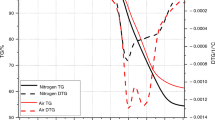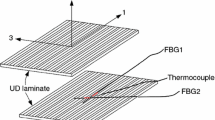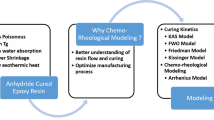Abstract
Curing course of Huntsman 1564/3486 epoxy resin system was studied under dynamic and isothermal curing conditions by differential scanning calorimetry technique. The autocatalytic cure kinetic model was established to describe the curing behaviour. A new modified phenomenological curing model based on the Olivier’s model was proposed to predict the relationship between the degree of cure and the couple of time and temperature. Then, the degree of cure was calculated by both the kinetic model and the modified Olivier’s model. A comparison of the results calculated with the experimental data show that the modified Olivier’s model is more accurate in the later stage of the curing course, especially at high temperatures. The modified Olivier’s model is simple and easy to use, could be applied to predict the degree of cure at isothermal temperatures well in engineering.










Similar content being viewed by others
References
Jenninger W, Schawe JEK, Alig I. Calorimetric studies of isothermal curing of phase separating epoxy networks. Polymer. 2000;41:1577–88.
Karkanas PI, Partridge IK. Cure modeling and monitoring of epoxy/Amine resin systems- Cure kinetics modeling. J Appl Polym Sci. 2000;77:1419–31.
Li M, Zhu Q, Geubelle PH, et al. Optimal curing for thermoset matrix composites: thermochemical consideration. Polym Compos. 2000;22:118–31.
Antonucci V, Giordano M, Hsiao KT, et al. A methodology to reduce thermal gradients due to the exothermic reactions in composites processing. Int J Heat Mass Transf. 2002;45:1675–84.
Vinnik RM, Roznyatovsky VA. Kinetic method by using calorimetry to mechanism of epoxy-amine cure reaction, Part I: Mangelsdorf’s approach. J Therm Anal Calorim. 2003;73:807–17.
Macan J. Study of cure kinetics of epoxy-silica organiceinorganic hybrid materials. Thermochim Acta. 2004;414:219–25.
Vinnik RM, Roznyatovsky VA. Kinetic method by using calorimetry to mechanism of epoxy-amine cure reaction, Part V: phenyl glycidyl ether–aniline. J Therm Anal Calorim. 2004;75:753–64.
Xie HF, Liu BH. Cure kinetics study of carbon nanofibers/epoxy composites by isothermal DSC. J Appl Polym Sci. 2005;96:329–35.
Arribas C, Masegosa MR, Salom C, et al. Epoxy/poly (benzyl methacrylate) blends: miscibility, phase separation on curing and morphology. J Therm Anal Calorim. 2006;86:693–8.
Román F, Montserrat S, Hutchinson JM. On the effect of montmorillonite in the curing reaction of epoxy nanocomposites. J Therm Anal Calorim. 2007;87:113–8.
Pagano RL, Calado VMA, Tavares FW, et al. Parameter estimation of kinetic cure using DSC non-isothermal data. J Therm Anal Calorim. 2011;103:495–9.
Mehran H, Mohammad HB, Masoud E. Cure kinetics of a glass/epoxy prepreg by dynamic differential scanning calorimetry. J Appl Polym Sci. 2011;120:62–9.
Kamal MR. Thermoset characterization for moldability analysis. Polym Eng Sci. 1974;14:23–6.
López J, Rico M, Montero B, et al. Polymer blends based on an epoxy-amine thermoset and a thermoplastic. J Therm Anal Calorim. 2009;95:369–76.
Montserrat S, Flaque C, Calafell M, et al. Influence of the accelerator concentration on the curing reaction of an epoxy-anhydride system. Thermochim Acta. 1995;269:213–29.
Lin KF, Shyu JY. Early cure behavior of a liquid dicyanate ester resin. J Polym Sci A. 2001;39:3085–92.
Liu HP, George GA. Study on the gelation of photocatalyzed dicyanate ester resins. Polymer. 1997;38:2997–3002.
Liu HP, George GA. Determination of thermal cure kinetics of thin films of photocatalysed dicyanate ester by FTIR emission spectroscopy. Polym Int. 2000;49:1505–12.
Deng Y, Martin GC. Effect of diffusional limitations on the gelation of cyanate ester resins. J Appl Polym Sci. 1996;64:115–25.
Deng Y, Martin GC. Diffusion phenomena during cyanate resin cure. Polymer. 1995;37:3593–601.
Christopher WW, Wayne DC, Andy AG. Chemico-diffusion kinetics of model epoxy-amine resins. Polymer. 1997;38:3251–61.
Olivier P, Cottu JP. Optimisation of the co-curing of two different composites with the aim of minimisting residual curing stress levels. Compos Sci Technol. 1998;58:645–51.
Olivier P, Cottu JP, Marinez JJ, et al. Optimisation of cure cycle parameters for a carbon epoxy laminate. 2nd international conference on deformation and fracture composites, Manchester; 1993. p. 29–31.
Lei Z, Xiao H. A variable reaction order model for prediction of curing kinetics of thermosetting polymers. Polymer. 2007;48:6125–33.
Dai XQ, Xiao JY, Zeng JC, et al. Curing kinetics of epoxy resin of RFI process using isothermal DSC. Acta Materiae Compositae Sinica. 2008;25:18–23.
Xu CW. Introduction of numerical analysis (in Chinese). 1st ed. Beijing: High Education Press; 1985.
Author information
Authors and Affiliations
Corresponding author
Rights and permissions
About this article
Cite this article
Liu, Z., Xiao, J., Bai, S. et al. Study on phenomenological curing model of epoxy resin for prediction of degree of cure. J Therm Anal Calorim 109, 1555–1561 (2012). https://doi.org/10.1007/s10973-011-2070-z
Received:
Accepted:
Published:
Issue Date:
DOI: https://doi.org/10.1007/s10973-011-2070-z




